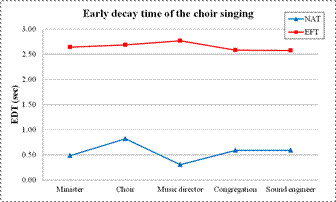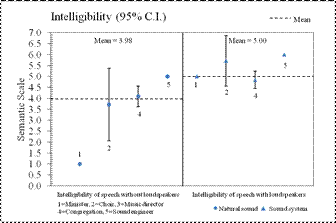
Figure 1- Early decay times (EDT) of the natural propagation ‘NAT’ of the choir singing and the artificial reverberation added to it by electronic effects ‘EFT’ in KBCG
Sang Bum Park – sbpark04@gmail.com
University of Florida
The School of Architecture
Gainesville, FL 32611
Popular version of paper 4aAA9
Presented Thursday morning, November 3, 2011
162nd ASA Meeting, San Diego, Calif.
1. Introduction
The general room acoustical study performs when the worship space is empty and measures objective acoustical parameters in the room. A survey is usually asked to people who are familiar with room acoustics or music, because they are well aware of the acoustical terminology that refers to a specific measure of acoustical quality of sounds. This has been used for concert hall research.
Soundscape concepts used to investigate the sound quality of natural and urban environment and the effects of sounds on people can be applied to study worship spaces. Worship activities such as the service of word and music mainly consist of aural activities in order for God to be able to hear their prayer and praise. The participants of worship are a minister, the choir, a music director, the congregation and a sound engineer in general. The participants’ locations would be different from that of the concert hall where the musicians and the audiences stay the same seating locations throughout the concert. The minister usually stays but moves on the platform not stuck in the seat. The choir stands on the chancel singing, but sits when the minister gives a sermon. In some churches, the choir move from the chancel to the congregational seating area after singing. When the choir is singing, the music director stands in the front center of the chancel facing the choir, otherwise usually seated on the side of the choir. On the other hand, the congregation and the sound engineer tend to stay their seating areas standing or sitting according to the liturgy, except that the sound engineer may check the electronic sound quality walking across the seating area. In general, the service of word delivered by ministers is reinforced or amplified by a sound system to enhance speech intelligibility, and the service of music such as the choir’s singing and organ music propagate sounds naturally in rooms.
2. Methods
Three worship spaces were chosen based on the three different levels of the use of sound systems; a reverberant space having a compact reinforcement system only for reinforcement of the service of the word [STMC.wav]; a live space having a sound system for reinforcement of the service of the word and music sometimes [FUMC.wav]; a dry space having a heavy sound system for amplification of the services of the word and music [KBCG.wav].
Background noise was measured in multiple locations to deal with the location of each participant group. Room acoustical measurement was performed based on the impulse response theory with multiple receiver and source locations so each can refer to the specific worship activities, sonic itineraries and their receivers while worship is ongoing. In addition, surveys was administered in the three worship spaces with questionnaires during the worship service and analyzed according to the specific seating locations and roles of the participants in the worship services.
3. Overall results and discussions
The sound pressure levels of worship activities ranged from 40.2 dBA during the silent prayer in FUMC up to 83.9 dBA when all participants was singing accompanying an organ and a piano in KBCG. The service of word reinforced by the sound systems ranged from 55 dBA to 77.6 dBA. Table-1 shows the sound pressure levels of worship activities measured in FUMC during Sunday worship.
Table 1- Sound pressure levels of worship activities of FUMC
Worship activities |
Frequency (Hz) |
Overall |
|||||||
125 |
250 |
500 |
1k |
2k |
4k |
8k |
|||
1 |
Silent prayer |
38.8 |
29.3 |
32.3 |
37.8 |
32.8 |
26.4 |
19.9 |
40.2 |
2 |
Natural talking in narthex and choir seats |
42.9 |
39.0 |
38.4 |
37.4 |
34.4 |
27.3 |
19.6 |
43.1 |
3 |
People stepping the stage |
56.6 |
45.9 |
43.1 |
41.5 |
37.0 |
32.1 |
25.2 |
47.4 |
4 |
Pastor's speech via loudspeakers |
50.5 |
44.1 |
52.1 |
43.9 |
43.4 |
41.9 |
27.9 |
55.0 |
5 |
Pastor's speech via loudspeakers |
52.6 |
48.0 |
53.7 |
48.3 |
44.4 |
36.9 |
30.2 |
56.9 |
6 |
Pastor's talking via loudspeakers |
55.9 |
51.7 |
56.3 |
52.4 |
49.5 |
43.9 |
36.7 |
60.5 |
7 |
Lay reader's bible reading |
48.6 |
50.6 |
57.7 |
51.5 |
50.6 |
43.4 |
33.7 |
60.9 |
8 |
Distant coughing |
45.7 |
55.7 |
68.9 |
52.4 |
51.5 |
42.5 |
32.6 |
62.0 |
9 |
People talking |
55.1 |
56.4 |
60.5 |
56.6 |
55.7 |
47.6 |
34.3 |
63.1 |
10 |
Congregational response |
61.4 |
63.4 |
68.8 |
57.6 |
56.1 |
50.8 |
46.9 |
67.7 |
11 |
Choir singing with a piano |
52.6 |
64.0 |
71.2 |
66.8 |
59.0 |
53.8 |
40.3 |
72.0 |
12 |
The whole community greeting each other |
62.6 |
66.3 |
71.6 |
68.3 |
61.8 |
52.1 |
41.3 |
73.6 |
13 |
People talking in narthex, choir seats and congregation seats |
63.1 |
68.5 |
72.6 |
67.4 |
65.1 |
56.3 |
45.3 |
74.0 |
14 |
Close coughing |
67.8 |
64.8 |
63.9 |
66.6 |
70.9 |
67.2 |
60.1 |
75.1 |
15 |
Only an acoustic pipe organ on the 2nd floor |
69.8 |
70.1 |
73.2 |
71.6 |
69.3 |
57.5 |
38.8 |
77.4 |
16 |
Pastor's speech measured on the 2nd floor |
68.2 |
70.6 |
74.2 |
71.6 |
69.2 |
61.0 |
43.4 |
77.6 |
17 |
The congregation and the choir singing with an acoustic pipe organ and a piano |
68.1 |
73.1 |
78.2 |
72.5 |
69.2 |
61.5 |
47.4 |
80.0 |
18 |
The congregation and the choir singing with an acoustic pipe organ |
67.1 |
74.2 |
78.0 |
78.6 |
67.5 |
60.5 |
39.9 |
80.4 |
19 |
The congregation and the choir singing with an acoustic pipe organ |
67.6 |
76.5 |
81.7 |
71.6 |
63.8 |
55.6 |
47.4 |
80.6 |
20 |
Congregational singing with an organ and a piano on the 2nd floor |
69.8 |
70.1 |
78.0 |
78.9 |
70.7 |
60.3 |
43.1 |
82.2 |
Background noise measurements showed that each group of participants of the worship space can experience different level of background noise at their seating location during the worship. In addition, the objective acoustical parameters measured were analyzed and discussed in the soundscape concept in regards to the relationship between the source and receiver during the worship. This could make it possible for one to quantify the worship activities such as the service of the word and music. Furthermore, the use of sound system changed the objective acoustical parameters measured and the subjective evaluation of the worship activities showing huge variation of the perception of the worship services. For example, the early decay time (EDT) values of the choir singing can be analyzed by the groups of the participants of the worship service as shown in Figure-1. In KBCG, the choir singing was picked up by two microphones hanging on the ceiling and the electronic effects which simulate the artificial reverberation were added to the original choir sounds, which in turn the congregation could hear more reverberant sounds as the EDT value increased by 1.99 sec (from 0.59 sec to 2.58 sec) at the location of the congregation which indicated about 437 % of increase.

Figure 1- Early decay times (EDT) of the natural propagation ‘NAT’ of the choir singing and the artificial reverberation added to it by electronic effects ‘EFT’ in KBCG
Furthermore, the survey showed that the overall intelligibility with the sound system 1.5 – 2 scale points higher than without in all worship spaces and especially the pastor in KBCG raised its value with the sound system from 1 scale point to 5 scale points as shown in Figure-2.

Figure 2- Intelligibility of speech with and without loudspeakers in KBCG